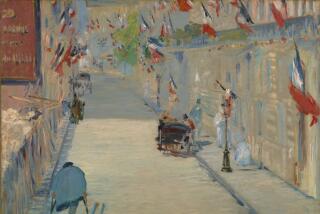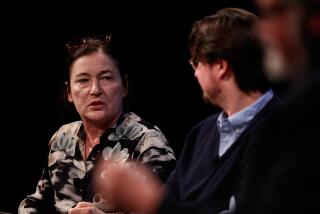A critic in the artist’s lair
“I am confessing my sins in advance, before I have committed them.”
So says the Scottish painter Henry MacAlpine, the protagonist of Iain Pears’ novel “The Portrait.” MacAlpine’s “confession” takes the form of a bantering monologue, and it quickly becomes clear that the disgruntled painter doesn’t want absolution -- he wants revenge.
As he has done in his other novels, Pears cleverly deploys the murder-mystery genre to explore the labyrinthine possibilities of narrative. His new novel takes place on the eve of World War I, on a wild and remote island off Brittany, France. MacAlpine, a successful portraitist, had gone there four years earlier, in exile from London. And there he is visited by William Nasmyth, a snobbish English art critic whose pronouncements can make or break a career.
MacAlpine and Nasmyth were once close friends, but Nasmyth, it soon becomes clear, has been responsible not only for MacAlpine’s success but also, in some mysterious way, for his flight to Brittany. The pretext for Nasmyth’s arrival is so that MacAlpine will paint the critic’s portrait and revive his career. More is at stake, though, than either the portrait or MacAlpine’s waning reputation.
Pears has carved out an enviable niche for himself. A trained art historian with a doctorate from Oxford University, he is the author of seven well-regarded crime novels featuring Flavia di Stefano of Rome’s Art Theft Squad. More famously, perhaps, he is the author of “An Instance of the Fingerpost” (1998) and “The Dream of Scipio” (2002) -- two long, erudite and intricately layered historical mysteries with dizzying narratives and, in the case of the latter, even more dizzying moral conundrums.
“The Portrait” is a beguilingly slender novel for readers used to his doorstop-size offerings -- and it’s possibly a welcome change for anyone wanting to slip a copy into their hand luggage for summer reading. Still, the relative brevity shouldn’t suggest that Pears has made things entirely easy for us.
As readers of Pears would expect, the narrative is not exactly straightforward. MacAlpine roams freely over his past life: his brutal childhood in Scotland (a place with “fifty-nine different shades of grey”), his boisterous student days in Paris and his unhappy entanglement with a talented painter named Evelyn, who once rejected his proposal of marriage. He also recounts the fate of his and Evelyn’s favorite model, a working-class woman named Jacky who apparently committed suicide and thereby -- as MacAlpine churlishly observes -- “deprived the world of many a fine picture.”
The novel is scattered with dead bodies such as Jacky’s. MacAlpine, it transpires, is fascinated with corpses and death. Besides his portraits of members of London society, he has a secret sideline in the macabre, painting what he calls his “dark pictures” -- portraits of suicides, murder victims, hanged criminals. “I became quite expert at depicting the effects of maggots,” he boasts to Nasmyth, “and of water, and of dog bites on tramps left too long in gutters; excellent in putting down in a few strokes of the pencil the beautiful red line that a knife across the throat will make.”
Michelangelo’s studies of corpses led to the figures in the Sistine Chapel, but we suspect MacAlpine will put his research to a less sublime employment. “Have you ever noticed,” he casually inquires, “that no artist has ever committed cold-blooded murder?” And so it appears that he may find himself in the avant-garde after all.
History insinuates its way unobtrusively into the novel despite a time frame freighted with incident. The key event of MacAlpine’s monologue is the Post-Impressionist exhibition staged in London in 1910, when the British public first saw the works of Gauguin, Van Gogh and Cezanne. Nasmyth has brought these latest French fashions across the Channel “to whack the English in the eye.” Yet moral rather than aesthetic practice is what really interests Pears. It is Nasmyth’s power and arrogance, his almost God-like control over other people’s lives, that heaves the plot into motion. “I persuade people to love what they hate, buy what they do not want, despise what they love,” he boasts.
Such power is all very well, Pears suggests, if a critic is honest and sincere. But what if he is motivated by self-interest? As MacAlpine demands of Nasmyth: “What if your cruelty and ruthlessness turned into promoting and defending yourself, rather than art?” Few will fail to exult as the tables are neatly turned on Nasmyth. “When you sit in that chair,” MacAlpine tells him, “you are stripped of your expertise, of your taste and discernment.... You are defenceless until I am finished.” We can only surmise how MacAlpine will finish his portrait.
A picture may well be worth a thousand words, but Pears’ prose is, thankfully, up to the challenge of painting skillful verbal portraits of the two antagonists. He sustains a delicately nuanced tone that ranges from chatty bonhomie and happy reminiscence to anger, accusation and menace. The ending comes with an unsettling revelation -- a sharp sting in the tail for which not even the grisliest aspects of MacAlpine’s story have quite prepared us. It is a book that fits very well into the hand luggage. *
More to Read
Sign up for our Book Club newsletter
Get the latest news, events and more from the Los Angeles Times Book Club, and help us get L.A. reading and talking.
You may occasionally receive promotional content from the Los Angeles Times.







